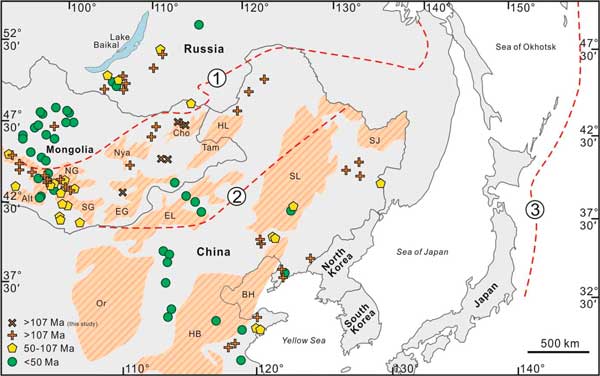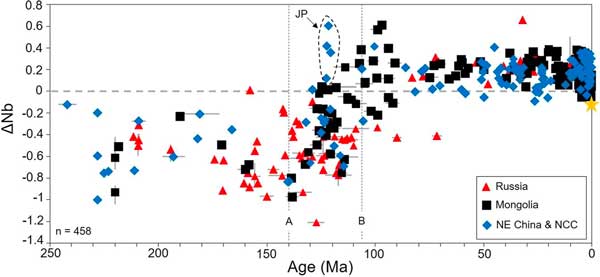|
Thomas Sheldrick & Tiffany Barry
School of Geography, Geology and the Environment, University of Leicester, University Road, Leicester, LE1 7RH, UK, thomassheldrick@gmail.com ; tlb2@le.ac.uk
This webpage is a summary of: Sheldrick, T.C., Barry, T.L., Dash, B., Gan, C., Millar, I.L., Barfod, D.N. and Halton, A.M., 2020. Simultaneous and extensive removal of the East Asian lithospheric root. Scientific Reports, 10(1): 4128, https://doi.org/10.1038/s41598-020-60925-3
The occurrence of widespread, intermittent Mesozoic-Cenozoic magmatism across East Asia is a geological conundrum – what drove the magmatic processes and significant lithospheric removal? Despite many studies1-16, little consensus has been reached about the cause of apparent lithospheric removal during the Mesozoic7-12, and intermittent follow-on magmatism13-15 Many models for Mesozoic and Cenozoic volcanism in East Asia converge on themes of interaction between subducted slabs and upwelling magma by either a cogenetic link with Paleo-Pacific slab roll-back, convective erosion above either a subducting or stagnated slab, or delamination due to thermo-chemical weakening of the lithospheric mantle16-22. Alternatively, models invoking mantle plumes have been proposed14. With so many localised studies, it can become hard to see the woods for the trees. Therefore, the idea behind some of our recent work was to place regional constraints on the timing of the widespread lithospheric removal and magmatism1 to help improve our understanding of it. In our study we combined extensive existing data from Eastern Asia with new data from southern and eastern Mongolia (Figure 1).

Figure 1: Map of Eastern Asia showing the age distribution of dated magmatic (basaltic) samples. Also shown is (1) the Mongol-Okhotsk Suture (remnant from the closure of the Mongol-Okhotsk Ocean), (2) Solonker Suture (remnant from the closure of the Paleo-Asian Ocean) and (3) Pacific plate active margin. Striped brown regions are sedimentary basins: NG, North Gobi; EG, East Gobi; Nya, Nyalga; Cho, Choibalsan. Tam, Tamtsag; HL, Hailar; Or, Ordos; HB, Huabei; BH, Bohai; EL, Erlian; SL, Songliao; SJ, Sanjiang. Crosses represent newly analysed samples in our study1.
We used melt compositions from dated basaltic samples only (>370 dated samples), from different volcanic fields across Eastern Asia, to evaluate source variation through time and space (Figures 1 and 2). Where geochemical data were not available for the dated sample, we averaged data for the sample locality instead, with a data range given for the minimum and maximum values for each point/locality (total number of samples = 459). Thus, we aimed to create one of the most comprehensive geochemical studies for East Asia to evaluate geochemical signatures with time.
Far-reaching concurrent lithospheric removal
A sensitive indicator of source characteristics is ΔNb (where ΔNb = 1.74 + log (Nb/Y) – 1.92 log (Zr/Y)). It is insensitive to the effects of mantle melting, source depletion by melt extraction, crustal assimilation and alteration processes23. Positive ΔNb values are consistent with a source from asthenospheric mantle or fertile lithospheric mantle that is not depleted in HFSEs; negative ΔNb values are consistent with a source depleted in Nb, such as a metasomatised SCLM. Assimilation-fractional crystallisation modelling (e.g., Refs. 15,16) and detailed petrological studies emphasise that crustal contamination was not a significant process in the genesis of the mafic volcanism included in our study. Most samples from Eastern Asia older than 107 Ma have negative ΔNb values (Figure 2), signifying a dominantly metasomatised SCLM source. Melts younger than 107 Ma from Mongolia and the NCC have values that are positive or close to 0, with Nb/La ratios >1. The general trend for samples between 140 Ma and 107 Ma is a gradual increase from negative to positive ΔNb values. This trend likely reflects a decrease in the involvement of the SCLM and crust, coupled with increasing asthenospheric input. We suggest this trend reflects a period of time (from 140 Ma to 107 Ma) when there was the greatest rate of metasomatised SCLM removal. Geochemical results suggest that magmatism before 107 Ma derived from metasomatised subcontinental lithospheric mantle (SCLM), whereas after 107 Ma, Mesozoic melt predominantly derived from an asthenospheric source. The switch to an asthenospheric magma source at ~107 Ma occurred in both Mongolia and North China (which are >1600 km apart!), whereas in eastern Russia the switch possibly occurred a little later (~85 Ma). More robust Ar-Ar dating would help constrain when the switch from negative, to positive, ΔNb values occurred in eastern Russia.

Figure 2: Time vs. ΔNb: geochemical variations through time and space for East Asian Mesozoic and Cenozoic volcanism where ΔNb = 1.74 + log (Nb/Y) −1.92 log (Zr/Y). Marker A = 140 Ma and Marker B = 107 Ma. JP = Jiaodong Peninsula; NCC = North China Caton; Yellow star = average MORB. Where geochemical data were not available for the dated sample, we have averaged data for the sample locality instead. Range bars show the minimum and maximum values for each point/locality. For more information, please see our article1.
Is the Intermittent Cenozoic magmatism exposing ‘ghost’ slabs in the upper mantle?
In our study, we also compile Sr-Nd-Hf isotope data on the Mesozoic-Cenozoic basaltic magmatism. We suggest that geochemical signatures for the Cenozoic magmatism point to an EM-1-like component which, along with positive ΔNb values and inferences from novel isotope studies, suggest origins within the upper mantle. A possible source for this EM-1-like component is ancient slab material/fluids. Such material could be in the form of metasomatic fluids but whether these derive directly from a coherent slab or are a component within otherwise upwelling mantle is unclear. East Asia, as part of the Central Asian Orogenic Belt, underwent a complex Palaeozoic and Mesozoic tectonic history, with the involvement of multiple large-scale tectonic systems and ocean closures which could have created a slab “graveyard”. Ultimately, whether such a slab graveyard drives the intermittent Cenozoic magmatism needs to be tested further, perhaps by utilising whole-mantle modelling with detailed geochemical studies to image and constrain slab dispersal. Such Mesozoic slabs have already been observed under Siberia, and further south in East Asia24.
Takeaway message and thoughts
This study clearly shows widespread concurrent lithospheric removal across Eastern Asia, with geochemical signatures changing at practically the same time, supporting a shared geological link across the region. It is remarkable that the metasomatised lithospheric mantle under Eastern Asia was all removed practically at the same time in the Mesozoic (~107 Ma). Understanding what caused magmatism in, say, Mongolia is likely to be key in understanding the destruction of the North China Craton or perhaps even magmatism in Eastern Russia. It would not be a stretch to say, even, that East Asia is perhaps the best region in the world to understand large-scale lithospheric removal processes.
References
(1) Sheldrick, T.C., Barry, T.L., Dash, B., Gan, C., Millar, I.L., Barfod, D.N. and Halton, A.M. Simultaneous and extensive removal of the East Asian lithospheric root. Scientific Reports, 10, 1-6 (2020).
(2) Menzies, M.A. and Xu, Y. Geodynamics of the North China craton. Mantle dynamics and plate interactions in East Asia, 27, 155-165 (1998).
(3) Barry, T.L. and Kent, R.W. Cenozoic magmatism in Mongolia and the origin of central and east Asian basalts. Mantle dynamics and plate interactions in East Asia, 27, 347-364 (1998).
(4) Zhang, H.F., Sun, M., Zhou, X.H., Fan, W.M., Zhai, M.G. and Yin, J.F. Mesozoic lithosphere destruction beneath the North China Craton: evidence from major-, trace-element and Sr–Nd–Pb isotope studies of Fangcheng basalts. Contributions to Mineralogy and Petrology, 144, 241-254 (2002).
(5) Barry, T.L., Saunders, A.D., Kempton, P.D., Windley, B.F., Pringle, M.S., Dorjnamjaa, D. and Saandar, S. Petrogenesis of Cenozoic basalts from Mongolia: evidence for the role of asthenospheric versus metasomatized lithospheric mantle sources. Journal of Petrology, 44, 55-91 (2003).
(6) Meng, Q.-R. What drove late Mesozoic extension of the northern China–Mongolia tract? Tectonophysics 369, 155-174 (2003).
(7) Gao, S. et al. Recycling lower continental crust in the North China craton. Nature 432, 892–897 (2004).
(8) Menzies, M., Xu, Y., Zhang, H. & Fan, W. Integration of geology, geophysics and geochemistry: A key to understanding the North China Craton. Lithos 96, 1–21 (2007).
(9) Vorontsov, A. A. et al. Magmatic sources and geodynamics of the early Mesozoic Northern Mongolia-Western Transbaikalia rift zone. Petrology 15, 35–57 (2007).
(10) Vorontsov, A. A. & Yarmolyuk, V. V. The evolution of volcanism in the Tugnui-Khilok sector of the western Transbaikalia rift area in the Late Mesozoic and Cenozoic. Journal of Volcanology and Seismology 1, 213–236 (2007).
(11) Andryushchenko, S. V., Vorontsov, A. A., Yarmolyuk, V. V. & Sandimirov, I. V. Evolution of Jurassic–Cretaceous magmatism in the Khambin volcanotectonic complex (western Transbaikalia). Russian Geology and Geophysics 51, 734–749 (2010).
(12) Windley, B. F., Maruyama, S. & Xiao, W. J. Delamination/thinning of sub-continental lithospheric mantle under Eastern China: The role of water and multiple subduction. American Journal of Science 310, 1250–1293 (2010).
(13) Hunt, A. C. et al. Cenozoic Volcanism on the Hangai Dome, Central Mongolia: Geochemical Evidence for Changing Melt Sources and Implications for Mechanisms of Melting. Journal of Petrology 53, 1913–1942 (2012).
(14) Yarmolyuk, V. V., Kudryashova, E. A., Kozlovsky, A. M., Lebedev, V. A. & Savatenkov, V. M. Late Mesozoic–Cenozoic intraplate magmatism in Central Asia and its relation with mantle diapirism: Evidence from the South Khangai volcanic region, Mongolia. Journal of Asian Earth Sciences 111, 604–623 (2015).
(15) Sheldrick, T. C., Barry, T. L., Van Hinsbergen, D. J. J. & Kempton, P. D. Constraining lithospheric removal and asthenospheric input to melts in Central Asia: A geochemical study of Triassic to Cretaceous magmatic rocks in the Gobi Altai (Mongolia). Lithos 296–299, 297–315 (2018).
(16) Sheldrick, T. C. et al. Evidence for southward subduction of the Mongol-Okhotsk oceanic plate: Implications from Mesozoic adakitic lavas from Mongolia. Gondwana Research 79, 140–156 (2020).
(17) Dash, B., Yin, A., Jiang, N., Tseveendorj, B. & Han, B. Petrology, structural setting, timing, and geochemistry of Cretaceous volcanic rocks in eastern Mongolia: Constraints on their tectonic origin. Gondwana Research 27, 281–299 (2015).
(18) Ma, L. et al. Lithospheric and asthenospheric sources of lamprophyres in the Jiaodong Peninsula: A consequence of rapid lithospheric thinning beneath the North China Craton? Geochimica et Cosmochimica Acta 124, 250–271 (2014).
(19) Bars, A. et al. Petrogenesis and tectonic implication of the Late Mesozoic volcanic rocks in East Mongolia. Geological Journal 53, 2449–2470 (2018).
(20) He, L. Numerical modeling of convective erosion and peridotite-melt interaction in big mantle wedge: Implications for the destruction of the North China Craton. Journal of Geophysical Research: Solid Earth 119, 3662–3677 (2014).
(21) He, L. Thermal regime of the North China Craton: Implications for craton destruction. Earth-Science Reviews 140, 14–26 (2015).
(22) Huangfu, P. et al. Thermo-mechanical controls of flat subduction: Insights from numerical modeling. Gondwana Research 40, 170–183 (2016).
(23) Fitton, J. G., Saunders, A. D., Norry, M. J., Hardarson, B. S. & Taylor, R. N. Thermal and chemical structure of the Iceland plume. Earth and Planetary Science Letters 153, 197–208 (1997).
(24) Van der Voo, R., Spakman, W. & Bijwaard, H. Mesozoic subducted slabs under Siberia. Nature 397, 246–249, https://doi.org/10.1038/16686 (1999).
last updated 1th October, 2021 |
